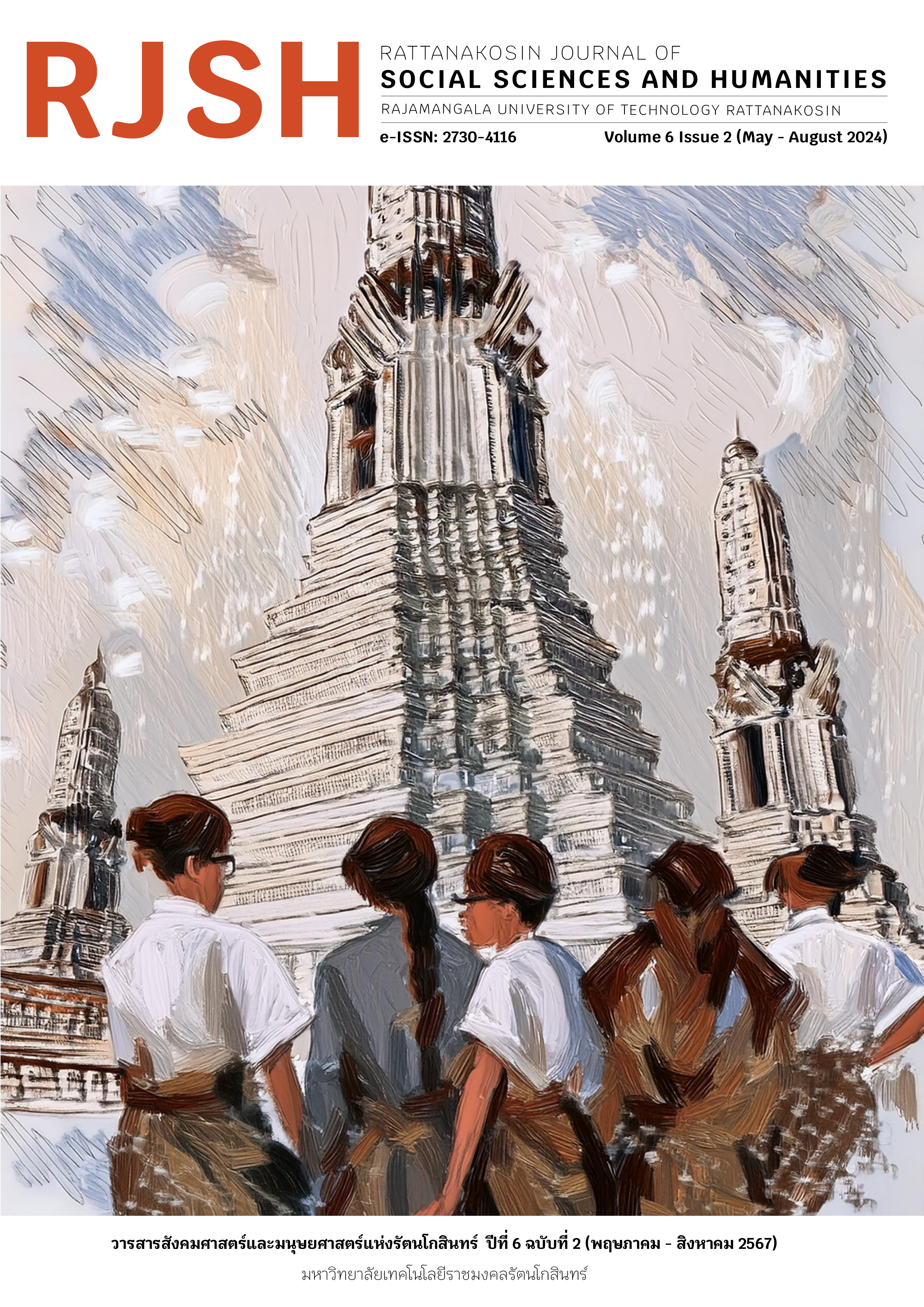การคาดคะเนการทุจริตจากงบการเงินโดยใช้แบบจำลองโครงข่ายประสาทเทียมสำหรับการตรวจสอบบัญชี
Main Article Content
บทคัดย่อ
การวิจัยนี้มีวัตถุประสงค์เพื่อพัฒนาแบบจำลองโครงข่ายประสาทเทียม (Artificial Neural Network: ANN) สำหรับตรวจจับแนวโน้มการทุจริตทางการเงินจากงบการเงินของบริษัทจดทะเบียนในตลาดหลักทรัพย์แห่งประเทศไทย ด้วยการทบทวนวรรณกรรมและแนวคิดที่เกี่ยวข้องกับทฤษฎีตัวแทน (agency theory) ที่มีความสัมพันธ์กับแนวคิดสามเหลี่ยมการทุจริต (fraud triangle) และการนำเสนองบการเงิน เพื่อตรวจหาการทุจริตด้วย Beneish M-Score ในแบบดั่งเดิม และความก้าวหน้าของเทคโนโลยีโครงข่ายประสาทเทียมที่สอดคล้องกับข้อจำกัดของการตรวจสอบข้อมูลที่จัดเก็บในรูปแบบฐานข้อมูลทำให้ผู้สอบบัญชีใช้เทคโนโลยีช่วยในการตรวจสอบบัญชี ดังนั้นการวิจัยนี้ใช้แบบจำลองโครงข่ายประสาทเทียมในการคาดคะเนการทุจริตจากงบการเงินได้อย่างรวดเร็วและแม่นยำเป็นเครื่องมือหลักในการวิเคราะห์และทำนายแนวโน้มการทุจริต ผลลัพธ์ที่ได้จากการประเมินประสิทธิภาพแบบจำลองที่พัฒนาขึ้นมีประสิทธิภาพสูง โดยแบบจำลองโครงข่ายประสาทเทียมที่ดีที่สุด (best model) มีค่าความแม่นยำโดยรวมร้อยละ 94.03 และปรับเทียบ (calibration) แบบจำลองแล้วมีค่าความเชื่อมั่น ร้อยละ 80.41 ส่วนผลการวิเคราะห์ Feature Importance ที่มีอิทธิพลในการคาดคะเนสูง คือ อัตราส่วนทุนหมุนเวียน (Current Ratio) ผลลัพธ์เหล่านี้บ่งบอกว่าแบบจำลองโครงข่ายประสาทเทียมที่พัฒนาขึ้นเป็นเครื่องมือที่มีคุณค่าสำหรับการวางแผนและปรับปรุงกระบวนการตรวจสอบบัญชีที่สามารถคาดคะเนการทุจริตในงบการเงินได้อย่างแม่นยำและน่าเชื่อถือ และอาจพัฒนาแบบจำลองโครงข่ายประสาทเทียมเป็นเครื่องมือการตรวจสอบภายในเพิ่มเติมได้
Article Details

This work is licensed under a Creative Commons Attribution-NonCommercial-NoDerivatives 4.0 International License.
ข้อความภายในบทความที่ตีพิมพ์ในวารสารทั้งหมด รวมถึงรูปภาพประกอบ ตาราง เป็นลิขสิทธิ์ของมหาวิทยาลัยเทคโนโลยีราชมงคลรัตนโกสินทร์ การนำเนื้อหา ข้อความหรือข้อคิดเห็น รูปภาพ ตาราง ของบทความไปจัดพิมพ์เผยแพร่ในรูปแบบต่าง ๆ เพื่อใช้ประโยชน์ในเชิงพาณิชย์ ต้องได้รับอนุญาตจากกองบรรณาธิการวารสารอย่างเป็นลายลักษณ์อักษร
มหาวิทยาลัยฯ อนุญาตให้สามารถนำไฟล์บทความไปใช้ประโยชน์และเผยแพร่ต่อได้ โดยต้องแสดงที่มาจากวารสารและไม่ใช้เพื่อการค้า
ข้อความที่ปรากฏในบทความในวารสารเป็นความคิดเห็นส่วนตัวของผู้เขียนแต่ละท่านไม่เกี่ยวข้องกับราชวิทยาลัยจุฬาภรณ์ และบุคลากร คณาจารย์ท่านอื่น ๆ ในมหาวิทยาลัยฯแต่อย่างใด ความรับผิดชอบองค์ประกอบทั้งหมดของบทความแต่ละเรื่องเป็นของผู้เขียนแต่ละท่าน หากมีความผิดพลาดใด ๆ ผู้เขียนแต่ละท่านจะรับผิดชอบบทความของตนเอง ตลอดจนความรับผิดชอบด้านเนื้อหาและการตรวจร่างบทความเป็นของผู้เขียน ไม่เกี่ยวข้องกับกองบรรณาธิการ
References
กรมบังคับคดี. (2566). DSI แถลงความคืบหน้ากรณีหุ้น STARK (คดีพิเศษที่ 57/2566). https://www.dsi.go.th/th/Detail/e34fb66360cc0cc2186 a1951f5aab66f
ผัลย์ศุภา หลงทอง และ นิ่มนวล วิเศษสรรพ์. (2562). ความสัมพันธ์ระหว่างความเสี่ยงที่เป็นระบบและอัตราส่วนทางการเงิน กรณีบริษัทจดทะเบียนในตลาดหลักทรัพย์แห่งประเทศไทย SET 100. นำเสนอในงาน The Rangsit Graduate Research Conference: RGRC, กรุงเทพมหานคร.
พรรณนิภา รอดวรรณะ. (2564). ระบบ Forensic Analytics ขั้นพื้นฐานในการตรวจสอบการทุจริตของงบการเงิน: กรณีศึกษาบริษัทในตลาดหลักทรัพย์แห่งประเทศไทย. วารสารสภาวิชาชีพบัญชี, 3(8), 4-21.
ศิลปพร ศรีจั่นเพชร. (2551). ทฤษฎีบรรษัทภิบาล. วารสารบริหารธุรกิจ มหาวิทยาลัยธรรมศาสตร์, 31(120), 1-4.
สภาวิชาชีพบัญชี ในพระบรมราชูปถัมภ์. (2555ก). ความรับผิดชอบของผู้สอบบัญชีเกี่ยวกับการพิจารณาการทุจริตในการตรวจสอบงบการเงิน [มาตรฐานการสอบบัญชี รหัส 240]. https://acpro-std.tfac.or.th/test_std/uploads/files/ TSA/2564_TSA240.pdf
สภาวิชาชีพบัญชี ในพระบรมราชูปถัมภ์. (2555ข). วัตถุประสงค์โดยรวมของผู้สอบบัญชีรับอนุญาตและการปฏิบัติงานตรวจสอบตามมาตรฐานการสอบบัญชี [มาตรฐานการสอบบัญชี รหัส 200]. https://acpro-std.tfac.or.th/test_std/uploads/files/TSA/2564_TSA200.pdf
สภาวิชาชีพบัญชี ในพระบรมราชูปถัมภ์. (2559). การแสดงความเห็นและการรายงานต่องบการเงิน [มาตรฐานการสอบบัญชี รหัส 700 (ปรับปรุง)].https://acpro-std.tfac.or.th/test_std/ uploads/files/TSA/2564_TSA700(Revised).pdf
สภาวิชาชีพบัญชี ในพระบรมราชูปถัมภ์. (2563). กรอบแนวคิดสำหรับการรายงานทางการเงิน [ประกาศสภาวิชาชีพบัญชี ที่ 48/2563] https://eservice.tfac.or.th/get_file/index.php? file=Frame%20work_03.10.66.pdf
ACFE. (2020). Report to the nations: 2020 global study on occupational fraud and abuse. https://www.acfe.com/report-to-the-nations/2020/
ACFE. (2021). Fraud triangle. https://www.acfe.com/ fraud-triangle.aspx%C2%A0
Anderson, D., & McNeill, G. (1992). Artificial neural networks technology. https://www.academia.edu/download/33786328/Artificial_ Neural_Networks _Technology.pdf
Bao, W., Yue, J., & Rao, Y. (2017). A deep learning framework for financial time series using stacked autoencoders and long-short term
memory. PloS one, 12(7), e0180944. https://doi.org/10.1371/journal.pone.0180944
Beneish, M.D. (1999). The detection of earnings manipulation. Financial Analysts Journal, 55(5), 24-36.
Beneish, M.D., & Vorst, P. (2020). The cost of fraud prediction errors. SSRN 3529662.
Caouette, J. B., Altman, E. I., Narayanan, P., & Altman, Z. (1968). 1.6 Z-score estimated for non-manufacturers & emerging markets. Altman Z-Score, 189(1).
Dashtbayaz, M.L., & Mohammad, S. (2015). Data search and discovery process for financial statement fraud. Research Journal of Finance and Accounting, 6(3), 75-80.
Healy, P.M., & Palepu, K.G. (2003). The fall of Enron. Journal of Economic Perspectives, 17(2), 3-26.
https://doi.org/10.1257/089533003765888403
Hribar, P., Kravet, T., & Wilson, R. (2014). A new measure of accounting quality. Review of Accounting Studies, 19(1), 506-538. https://doi.org/10.1007/s11142-013-9253-8
Japkowicz, N. (2001). Supervised versus unsupervised binary-learning by feedforward neural networks. Machine Learning, 42, 97-122.
Jensen, M.C., & Meckling, W. H. (1976). Theory of the firm: Managerial behavior, agency costs and ownership structure. Journal of financial economics, 3(4), 305-360.
Jiang, W. (2021). Applications of deep learning in stock market prediction: Recent progress. Expert Systems with Applications, 184, 115537. https://doi.org/10.1016/j.eswa.2021.115537
Kak, S. (1993). On training feedforward neural networks. Pramana, 40(1), 35-42. https://doi.org/10.1007/BF02898040
Kim, S., & Upneja, A. (2014). Predicting restaurant financial distress using decision tree and AdaBoosted decision tree models. Economic Modelling, 36, 354-362. https://doi.org/10.1016/j.econmod.2013.10.005
Kusumawati, A., & Syamsuddin, S. (2018). The effect of auditor quality to professional skepticsm and its relationship to audit quality. International Journal of Law and Management, 60(4), 998-1008. https://doi.org/10.1108/IJLMA-03-2017-0062
Lechner, M. (2020). Learning representations for binary-classification without backpropagation. In 8th International Conference on Learning Representations (pp 1-17). Virtual; Addis Ababa, Ethiopia: ICLR.
Mubako, G., & O'Donnell, E. (2018). Effect of fraud risk assessments on auditor skepticism: Unintended consequences on evidence evaluation. International Journal of Auditing, 22(1), 55-64. https://doi.org/10.1111/ijau.12104
Nawaiseh, A.K., Abbod, M.F., & Itagaki, T. (2020). Financial statement audit using support vector machines, artificial neural networks and K-nearest neighbor: An empirical study of UK and Ireland. International Journal of Simulation Systems, Science & Technology, 21(2), 1-6. https://doi.org/10.5013/IJSSST.a.21.02.07
Omar, N., Johari, Z.A., & Smith, M. (2017). Predicting fraudulent financial reporting using artificial neural network. Journal of Financial Crime, 24(2), 362-387. https://doi.org/10.1108/JFC-11-2015-0061
Pricewaterhousecoopers. (2020). Staying on top of a never-ending war. https://www.pwc.com/th/en/consulting/forensic/economic-crime-and-fraud-in-thailand.html
Rahim, S., Muslim, M., & Amin, A. (2019). Red flag and auditor experience toward criminal detection through professional skepticism. Jurnal Akuntans, 23(1), 47-62. https://doi.org/10.24912/ja.v23i1.459
Suryandari, N., & Yuesti, A. (2017). Professional scepticism and auditors ability to detect fraud based on workload and characteristics of auditors. Scientific Research Journal (SCIRJ), 5(9), 109-115.
Topor, D.I. (2017). The auditor's responsibility for finding errors and fraud from financial situations: Case study. International Journal of Academic Research in Accounting, Finance and Management Sciences, 7(1), 342-352. https://doi.org/10.6007/IJARAFMS/v7-i1/2862
Turner, J.L., Mock, T.J., & Srivastava, R.P. (2003). An analysis of the fraud triangle. The University of Memphis, University of Southern California, University of Kansas.
Yazid, H., & Suryanto, T. (2017). IFRS, professional auditor skepticism, conflict agency to prevention of fraud and investor confidence level. International Journal of Economic Perspectives, 11(1), 250-259.

